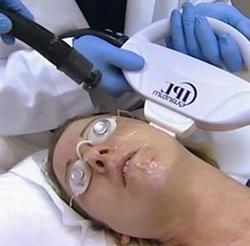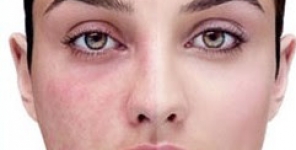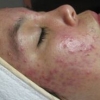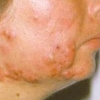Combinazione di luce pulsata intensa e trattamenti laser CO2 frazionati, per pazienti con acne e lesioni infiammatorie e cicatriziali
 Diverse sorgenti laser e di luce sono sempre più utilizzate nelle dermatologia estetica.
Diverse sorgenti laser e di luce sono sempre più utilizzate nelle dermatologia estetica.
Obiettivo.
Valutare l'efficacia e la sicurezza della combinazione di luce pulsata intensa (IPL) e del laser alla CO2 frazionato, per il trattamento di pazienti con acne e lesioni sia infiammatorie che cicatriziali.
Metodi.
Nel complesso, sono stati trattati 37 pazienti cinesi con acne e lesioni facciali infiammatorie e cicatriziali. Il trattamento si è basato su sessioni successive di 4-6 trattamenti con IPL, seguite da 2 sedute di trattamento con laser alla CO2 frazionato. L'efficacia è stata determinata dalla valutazione del dermatologo, dall'auto-valutazione del paziente, e dai dispositivi che misurano il colore della pelle, la secrezione sebacea e l'idratazione della pelle.
Risultati.
I trattamenti con IPL hanno ridotto significativamente il punteggio delle lesioni infiammatorie e il punteggio delle cicatrici atrofiche, rispetto al basale. I trattamenti successivi con laser alla CO2 frazionato hanno ulteriormente diminuito il punteggio delle cicatrici atrofiche. Entrambi i punteggi sono rimasti bassi quando i pazienti sono stati visitati dopo 6 mesi. Circa il 90% dei pazienti ha sperimentato un notevole o moderato miglioramento generale, e quasi l'80% dei pazienti ha valutato i risultati come 'eccellenti' o 'buoni'. L'indice di melanina (MI), l'indice di eritema (EI) e il livello di sebo nella pelle sono tutti diminuiti significativamente dopo i trattamenti con IPL, e EI e il livello di sebo sono risultati ancora bassi al follow-up dei 3 mesi anche se MI era di nuovo aumentato. Gli effetti collaterali (AEs) di entrambi i trattamenti sono stati transitori e sopportabili.
Conclusioni.
IPL in combinazione con laser alla CO2 frazionato è risultato efficace nel trattamento di pazienti con acne e lesioni infiammatorie e cicatrici atrofiche, e gli AEs sono stati accettabili.
Storia della pubblicazione:
Titolo: Combination of intense pulsed light and fractional CO2 laser treatments for patients with acne with inflammatory and scarring lesions
Rivista: Clinical and Experimental Dermatology. doi: 10.1111/ced.12010
Autori: B. Wang, Y. Wu, Y.-J. Luo, X.- G. Xu, T.-H. Xu, J. Z. S. Chen, X.-H. Gao, H.-D. Chen, Y.-H. Li
Affiliazioni:Department of Dermatology, No. Hospital of China Medical University, Shenyang, China Sheftel Associates Dermatology, Tucson, AZ, USA
Abstract:
Background. Various laser and light sources are been used increasingly in cosmetic dermatology. Aim. To evaluate the efficacy and safety of combination intense pulsed light (IPL) and fractional CO2 laser in treating patients with acne with both inflammatory and scarring lesions. Methods. In total, 37 Chinese patients with acne with facial inflammatory and scar lesions were treated. Successive sessions of 4–6 IPL treatments followed by 2 sessions of fractional CO2 laser treatments were applied. Effectiveness was determined by the dermatologist’s evaluation, patient self- assessment, and devices that measure skin colour, sebum secretion and skin hydration. Results. IPL treatments significantly reduced the inflammatory lesion score and the atrophic scar score compared with baseline. Subsequent fractional CO2 laser treatments further decreased the atrophic scar score. Both scores remained low when patients were followed up at 6 months. Around 90% of the patients experienced significant or moderate overall improvement, and almost 80% patients rated their results as ‘excellent’ or ‘good’. The melanin index (MI), erythema index (EI) and skin sebum level all significantly decreased after IPL treatments, and the EI and sebum level were still low when assessed at the 3-month follow-up, although the MI had increased again. The adverse effects (AEs) of both treatments were transient and bearable. Conclusions. IPL in combination with fractional CO2 laser was effective in treating patients with acne with both inflammatory lesions and atrophic scars, and the AEs were acceptable.





